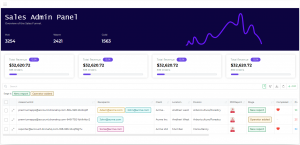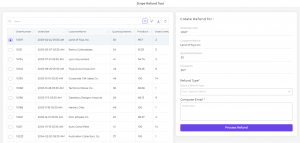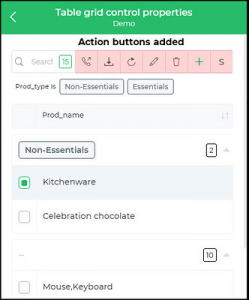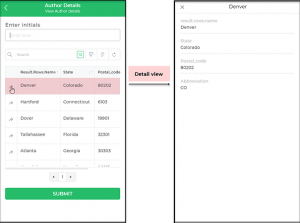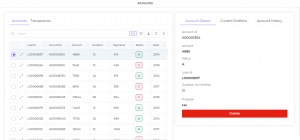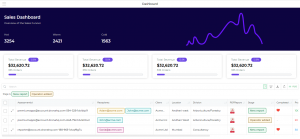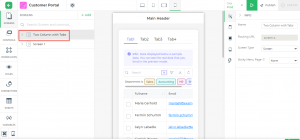

Building Interactive Admin Panels
If you need to manage inventory, edit customer orders, or search for the most frequent shopper, You would do it through admin panel! Admin panels have proven their worth in the workplace be it for:
- Customer database management – easily accessing custom orders, tickets, and payment information securely
- Inventory management – tracking key inventory metrics like stock levels, outbound inventory
- Bug tracking – moderating and fixing bugs in your product/app
A tailor-made admin panel has the potential to increase productivity, give insight into data, and help you catch bugs; adding up to greater revenue for your business. By investing in the admin panels early, you are going to build your application or run your processes much more efficiently and allow your team to do what they need to make your business grow.
What is an admin panel?
It is an admin-specific interface that enables its end-user to access, view and manipulate data that represents an entire or a part of a database, an enterprise system like a CRM or an HRMS, or even a spreadsheet. The Admin Panel helps in admin roles such as insights into user behavior on your app or website, new customer tickets, refund management, or tracking deliveries. Although these are called admin panels, these are not just limited to the admin user. A well-built admin panel can encompass a broad range of data and present it in a unified dashboard to display key business KPIs and analytics in real-time without anyone required to write the code for it.
The same admin panel can further be used to generate and export reports or send out email updates like the example below:
Admin Panels Customization & Integration: How Far Can You Go?
There are few off the shelf options for building admin panels like Database GUI Clients (for simple CRUD operations), Frontend admin libraries (that require you to write code and get decent UX, good for monitoring or firefighting), Backend admin libraries (for your apps) – and while they are all great at their specific function, some are either impossible or very difficult to extend beyond their basic functionalities resulting in challenges in maintenance and infrequent usage, or will be used by people who are technical.
Building Admin Panels with DronaHQ
DronaHQ gives all the benefits of using a ready admin panel but is much faster to build with, extend, customize and maintain. DronaHQ has a set of standard components such as tables, lists, text inputs, charts, graphs, etc. (with new components added every week) that you can drag-and-drop to build your custom admin panels.
These components make UI development a lot more easy to instantly visualize the various data points in different views. The added bonus comes with easy API integrations. DronaHQ can integrate with your data wherever it may be. You can connect to most databases or anything with a REST API in addition to using ready connectors to 3rd party tools like google sheets, firebase, slack, and more. What typically would require you to write the actual API request to fetch and populate app UI; with DronaHQ can be done in a few clicks with over 50+ database connectors and API connectors to popular data sources like Postgresql, MongoDB, MySQL, Airtable, Google Sheets, and many more. Here is the complete list.
You can bind the UI components with one of your databases or API and do anything from simple CRUD operations to extensive workflow automation.
DronaHQ’s Purpose-built UI component for Admin Panels: The Table Grid
Now that we’ve established that you can easily connect to any of your data sources, let’s look at what makes admin panels development so easy on the DronaHQ platform. Among the 200+ UI components available on the platform, we have some components that were purpose-built to create data visualizations and admin panel tools. The Table grid control is one of them.
Table grid control is a display control that is used to fetch the data from a data source and display the contents to the user. This component makes basic CRUD operations easy to do, and for more complicated workflows, you can combine the Table Grid into custom interfaces. You can hook them up to database queries or API endpoints that do whatever everyday business tasks you have.
Whenever I build an app on Studio, I use the new table grid because it helps me to showcase all the information in one place and is pretty damn powerful!
— Aneesh Dhairyawan
This component allows us to fetch and display information that can be double-clicked to see detailed views or can be used for a top-level moderation. Using the table grid You can set queries up to extract your metrics in real-time.
The columns of the table grid can be customized with more user-readable labels, font customizations, and format types to store different types of data ranging from simple numeric data and text to URLs, Images, JSON files, and more.
Moreover, this control can be used to enable offline access as well as you can enable caching. Read here about caching and offline access.
The table grid comes with essentials like sort and filter, search by, and buttons to perform operations like Call, Download, Refresh, Edit, Delete, Add and the actions performed by these buttons can be configured as per your requirements.
It’s far more secure since you can build custom UIs for fighting specific fires, and role out access to only some parts of your database to those who need it.
Here is how you use Table Grid Control > https://www.youtube.com/watch?v=ylEEOCzAG5Y
With the detail view used in combination with the table grid, you can easily create drill-down reports that can expand on the row you selected and use a specific field to fetch and display information from another data source, say looking up the customer contact details from the CRM for a new ticket received on the ticket management system.
The detail view can be used to perform all kinds of operations like sending an email, getting authorization, generating reports, and tracking processes.
The Table Grid control & everything you need to know about it > https://community.dronahq.com/t/table-grid-control/190
Examples and Ready Templates
1. Admin Panel for Sales – An admin panel to view your Sales dashboard and manage your stores’ Customers, Products, and Transactions history. View, update and delete Customers, Products, and Transactions and view Orders for each selected Customer.
2. Postgresql Admin Panel – An admin panel for managing your Customer data, built on PostgreSQL. This app lets you view, update and delete Users, Products and view and refund Orders for each selected Order.
3. MongoDB Admin Panel – An admin panel for managing your accounts data, built on MongoDB. This app lets you view and delete accounts and view and add transaction details.
4. Advanced Dashboard – This is an Advance app that provides a thorough dashboard for sales teams to gain insight into the sales and provide demand forecasts, drive new ideas, and even.
5. Stripe Refund Tool – A handy tool to help you to pull in problematic orders, review the complaint, initiate refunds, and send a notification email. Here the App takes care of the customer data from your internal tool, uses Stripe to process the actual refund, and then sends the refund confirmation email.
Conclusion
There is no one-size-fits-all solution when it comes to admin panels. Custom-built admin panels have the capacity to address broader and more specific business needs through deep customization and integration.
Say, you are building an admin panel to monitor data collected from a network of machines in your factory. And you want the admin panel tailored to users’ expectations for the design and functionality. Unless your developers’ needs are covered by one of the ready-made solutions available on the market, going for a customizable admin panels will probably be the optimal option.
DronaHQ is making it easier for developers to build the UI for an application’s back-end. Imagine a set of ready-to-use screens and elements (like tables, lists, charts, and icons) that you can push to prod in almost no time. If you’re building, and you have multiple custom tools you’re looking to build, you should try DronaHQ. It’s as quick to get started as a backend admin. And flexible enough for a variety of use-cases that can be modified as your needs change and grow. Try it for free!

